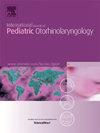Auditory modulation processing in children with mild to moderate hearing loss
IF 1.2
4区 医学
Q3 OTORHINOLARYNGOLOGY
International journal of pediatric otorhinolaryngology
Pub Date : 2025-03-30
DOI:10.1016/j.ijporl.2025.112330
引用次数: 0
Abstract
Background and objective
Children with hearing loss often have difficulty understanding speech in noisy environments like classrooms, leading to educational and communication challenges. Detecting and discriminating auditory spectro-temporal fundamentals is essential for speech comprehension. So, in this study, we investigated how children with mild to moderate hearing loss (MMHL) process these auditory modulations and their relation to speech perception in noise, comparing their performance to that of children with normal hearing.
Methods
This cross-sectional study selected 31 children with mild to moderate sensorineural hearing loss (SNHL) and 34 normally hearing (NH) children, aged 8 to 12. After obtaining consent, participants underwent tests, including the Spectral Modulation Ripple Test (SMRT), Amplitude Modulation Detection Tests (AMDTs) at 10, 50, and 200 Hz, and Speech Perception in Noise (SPiN) assessments using Word-in-Noise (WIN) and BKB-SIN tests, conducted monaurally. Results were compared between the two groups, evaluating the effects of hearing loss severity and correlations among the tests, as well as score comparisons from both ears within each group.
Results
Significant differences were observed between groups (MMHL and NH) in SMRT, AMDTs, and SPiN tests (p < 0.05), with the NH group scoring better. However, no significant differences were observed between mild and moderate hearing loss (p > 0.05). There was no correlation between SMRT and AMDTs with the WIN test (p > 0.05). Notably, significant correlations were found between SMRT and BKB tests in both groups. Sporadic correlations were also identified between AMDTs at higher rates and BKB results for both groups (p < 0.05). Scores between the two ears showed no significant differences across all tests (p > 0.05).
Conclusion
Children with Mild to moderate SNHL have a lesser ability to use spectral and temporal modulation information, making it difficult for them to understand speech in noisy environments. Nonverbal spectral and temporal modulation tests require minimal cognitive effort and are valuable for evaluating perceptual disorders and developing auditory rehabilitation programs for these children.
求助全文
约1分钟内获得全文
求助全文
来源期刊
CiteScore
3.20
自引率
6.70%
发文量
276
审稿时长
62 days
期刊介绍:
The purpose of the International Journal of Pediatric Otorhinolaryngology is to concentrate and disseminate information concerning prevention, cure and care of otorhinolaryngological disorders in infants and children due to developmental, degenerative, infectious, neoplastic, traumatic, social, psychiatric and economic causes. The Journal provides a medium for clinical and basic contributions in all of the areas of pediatric otorhinolaryngology. This includes medical and surgical otology, bronchoesophagology, laryngology, rhinology, diseases of the head and neck, and disorders of communication, including voice, speech and language disorders.

 求助内容:
求助内容: 应助结果提醒方式:
应助结果提醒方式:


